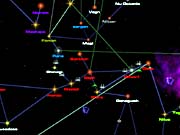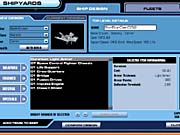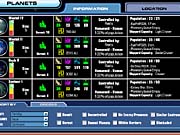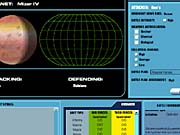Master of Orion III Hands-On Preview
Here are our hands-on impressions of the much-anticipated third game in the classic space strategy series, which is now nearly complete.
It's been nearly a decade since MicroProse released Master of Orion and set the standard for space empire games. Master of Orion came out shortly after Civilization, and it's possible to see some parallels between the two games, which both reached a broad audience despite the long play sessions they required--perhaps in part because of abstract, simplified mechanics that gave you the sense that you were always in the middle of important events, galactic or historical. The two franchises have found a new home at Infogrames but have grown in somewhat different directions over the years. Now that we've had ample time to play a near-finished build of Master of Orion III, it's evident that the designers of the upcoming game spent a lot of effort in modeling how galactic empires might work. The game packs in a lot of complexity for hard-core fans of space empire games, and those who generally like grand strategy may be consoled by the fact that there's a lot of automation of low-level tasks to minimize micromanagement and keep the turns moving quickly.
Master of Orion helped define the genre of "4X" space empire games with a design that encompassed empire management, custom spaceship design, diplomacy, spying, tactical ship combat, and automated ground combat. The second game in the series added another layer of sophistication by modeling colony management in more detail and by having multiple planets per star system. The upcoming third game seems to follow in Master of Orion II's footsteps and maintains the vast scale implied in having galaxies that can have from 50 to 200 stars, where each star has between one and a half-dozen or so orbiting planets. Before starting a game, there are seven different galactic configurations to choose from, including four sizes of amorphous cluster galaxies and three sizes of spiral galaxies, which have two or three widely separate arms of stars spiraling out to create chokepoints for potentially easier territorial control.

Part of what has made the new Master of Orion game such an ambitious project is that it includes all the gameplay elements of the games that have come before it and has added extra layers of realism to nearly every part of the formula. Given the sheer number of planets that you're likely to control on a medium-sized map, some might theoretically expect that it's difficult to keep track of what's going on. However, after getting past the initial learning curve with the help of an in-game tutorial for each of the game's many screens, it's not hard to use a light hand to keep an empire running smoothly while the turns fly by.
One interface element that helps is the SitRep, or situation report, screen that opens at the start of every turn. Events that occurred during the turn are classified as being of red, yellow, or green importance, and if you want more detail on an event or want to act on it, there's usually a hyperlink embedded right there that takes you directly to the screen you need. Many turns won't require much player intervention at all, as the game often seems paced to make each turn like a baby step and keep you clicking through turns in rapid succession. What makes this possible is the automation that helps run your empire at many levels of the game, including planetary management, research, and combat. However, such important tasks as diplomacy, spying, designing ships, and creating new groups of starships are left completely up to you.

The initial exploration of star systems and subsequent buildup of colonies is characteristic of space strategy games, and it's no different here, although the larger maps are so huge that it may literally take a couple hundred turns to explore the majority of star systems in your part of the galaxy, depending on the number of enemy opponents. The game models planets in some detail, breaking them up into regions. Each region can support up to two of the major types of infrastructure buildings. The advantage of this system is that there's usually some diversity to the region types, so even barren planets usually have one fairly fertile region suitable for effective farming, and mineral-poor planets can support some mining. There's a ton of detail on the planet screen, probably more than in any other part of the game, including pop-up screens with a bunch of financial sliders and specific information on infrastructure, population, environmental terraforming, and ground troops.
Fortunately, the planet AI seems pretty good at developing a planet's infrastructure according to its natural resources and to high-level goals set in the empire screen. Much of the time, you may just tweak your major planets' build queues and leave the rest to the automation. Only big crises--such as a local uprising that needs to be mollified with lower taxes or outright suppressed, a military threat, or a planetary blockade that blocks food imports--really require you to pay close attention to minor planets. In those cases, a planet's AI can be turned off so it won't mess with your new priorities.
Getting Into Action
It often won't take long to establish relations with other alien species. The game includes some 16 prebuilt species, each with its own strengths and weaknesses. There's also the option to customize a race by reallocating skill points. The large number of races and their decidedly alien-sounding names may make it hard to differentiate between your enemies and allies, but at least you'll know what they look like. It turns out that the best of the in-game graphics are the various prerendered animations you'll see when conducting diplomacy. The diplomacy system has a full range of proposals for you to make, including various levels of courtesy, but there isn't all that much feedback on why something is or isn't working or why an alien empire just declared war on you.

Espionage can be a powerful tool for creating discord and destruction in the enemy's ranks before actually resorting to military action. There are spies specialized in a variety of actions, such as reducing military preparedness, blowing up infrastructure, causing diplomatic discord, or slowing down research. The actual mechanics are very simple: Train spies in a given area and set them on a given empire. Counterspying isn't really an option, and the only way to reduce the effectiveness of enemy spies is to turn up the "oppressometer" setting that trades your population's happiness for better internal security. The results of espionage for and against your empire show up in the SitRep screen, and if you're in close contact with other empires, you can expect both friends and enemies to be pesky in blowing up buildings and sabotaging research. As often as these setbacks can occur, it's fortunate that the AI can handle the reconstruction effort.
When the action heats up, it's likely that you will want to take a front seat in designing solid frontline ships and sending them into battle. Stars are connected by a constellation of paths to nearby stars, but not all stars connect to their neighbors, which means that some stars have a much greater strategic importance than others for maintaining borders. It's possible to build three basic kinds of ships: starships with warp drives, system ships that are cheaper and have more room for weapons, and star bases. The system ships are good as a local garrison, and it's best not to allow even a friendly empire's ships to hang around one of your systems, since they'll blockade it by default.
To actually move starships from system to system it's first necessary to create a task force, which can contain from one ship to dozens of ships and must be specialized in a role like long-range attack, carrier operations, or troop transport, though support ships can have other roles. Forming a task force takes one turn, and disbanding one can take several, but the advantage of this sort of organization is that fleets can be classified by function and move as a group in tactical battles, with three concentric rings to protect critical ships at the core. Ship combat can be left to the AI to control offscreen or while you watch. There are a few options for the player who decides to control tactical combat--mainly just movement, attack, and retreat orders. The ships fire automatically when targets are in range. Battles will be mostly decided before they start, as the player with the most and best ships should carry the day.

There are a few steps to researching better technologies for ships and colonies. First, your scientists work away at theoretical research, advancing your technological prowess in six areas from level 1 at the start of the game to a maximum of level 50. Then, at most levels, some new technologies become available for practical development. Finally, before you can put ship-bound technologies into use, it's first necessary to complete a prototype. As it works out, it's possible to glance only occasionally at the research screen to see what new goodies are available and let the AI take care of research the rest of the time. An unexpected limitation on effective long-term research does seem to be that you can't upgrade existing fleets to use new technology. While the game has a convenient autobuild feature to immediately design ships with the optimal loadout for a role, as the turns wear on, this seems to make for fleets that are composed of many different designs.
It's hard to get a grasp on a grand strategy game by looking at screenshots. Graphics aren't the main attraction of Master of Orion III, but the visual presentation seems better than you'd expect from the screenshots that have been released. The blue menus have a good feel, with decent transition animations. But there's no doubt that there are a ton of information screens, which will be confusing for some. One element of the game that doesn't look much better when seen close-up is the tactical combat.
The last chapter of Master of Orion III's long development history has been one of slipping release dates. But while Infogrames hasn't yet announced that the game has gone gold, it does seem very near to completion. Our preview build was accompanied by a final manual and the official strategy guide, which has already been released. Even the second play disc looked to be from a final, mass-production run. Only the install disc betrayed the game's still-beta status, as Quicksilver is still making some tweaks to the game's multiplayer stability. The single-player matches we tried out proved to be perfectly stable and reasonably polished, so you can pretty much expect the game to perform as promised when the game arrives on store shelves sometime after the holidays. It's another question as to whether Master of Orion III's complex gameplay will prove as popular as the first two games in the series.
Got a news tip or want to contact us directly? Email news@gamespot.com
Join the conversation